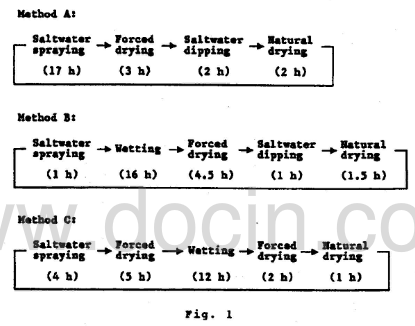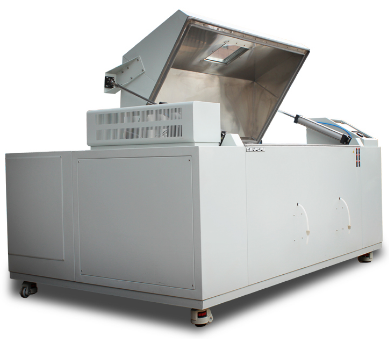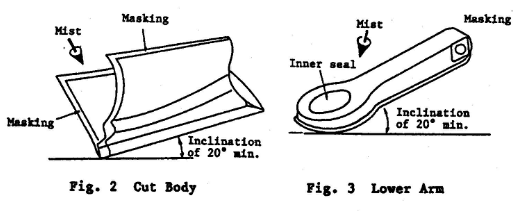Environmental test chambers for standard TSH 1555G Test method for accelerated corrosion under complex environment
This standard covers the test method for reproduction, at an accelerated pace, of corrosion on each part of a vehicle body, in order to simulate the corrosion produced on actual vehicles. This is a complex environment cycle test in which a wetting/drying cycle is repeated once every day. For the test, one of the 3 methods shown below shall be used. This standard needs a climatic chamber--salt spray test chamber.

For method A, continual saltwater shall be carried out during company holidays of up to three days duration, and natural drying shall be carried out during company holidays of four days or more. For method B and C, on the other hand, natural drying shall be carried out on holidays regardless of their length. Total hours of continual saltwater spraying(not applicable to methods B and C) and natural drying on holidays shall be reported for both methods A, B and C.

1. Saltwater Spraying
Saltwater spraying shall be carried out in accordance with TSH 1555G. Temperature inside the saltwater preheater, humidifier, and sprayer shall be maintained at 50±1℃ continually during the test period.
2. Saltwater Dipping
After placing the test specimens in a plastic vessel, fill the vessel with salt water prepared in accordance with TSH 1555G until the specimens are completely immerses. Put a lid on the vessel and store it in a thermostatic oven controlled at 50℃±1℃ by the time the test specimens are immersed.
3. Forced Drying
Place the test specimens in a dryer equipped with a ventilation fan in such a manner that they dry easily.Increase the dryer temperature from room temperature to 70℃with the fan being operated, and maintain the temperature at 70℃±1℃ for the specified time period.
4. Natural Drying
Leave the test specimens placed in a room in such a manner that they dry easily. Though no special ventilation is required, it is advisable to maintain the room temperature at 20 to 30℃ during the test period.
5. Wetting Condition
Expose the test specimens to a temperature of 50±1℃ in humidity of 85 to 90% for the specified time period.
The standard test period shall be 60 cycles(about 3 months). During this period, pick the specimens up when the test cycle has reached number 30 and check the progress of corrosion. The quantity of the test specimens to be prepared, if at least n=2 is required, is four pieces for one type.
Test specimen preparation:
1. Raw steel sheet and coated steel sheet
Cover the edges and reverse faces of the steel sheets with highly water-resistant aluminum tape.
When data on mass loss is required, degrease and dry the steel sheets before the test, and then weigh them.
2. Cut body and parts
Cover every edge with highly water-resistant aluminum tape. If there are certain edges that cannot be covered due to their shape, cover them completely with the rust preventive wax specified in TSK7507G or an equivalent. In this case, leave the specimens at ordinary temperature for at least 2 days. Sections other than those to be subjected to the evaluation are likely to have rust form in a comparatively short time. Hence, apply a rust preventive wax for rust prevention.
3. Cross cut
For panels coated with a highly rust-preventive paint, the corroding condition depends largely on the cross cutting manner; that is how strongly and in what direction the knife edge is moved. Accordingly, it is recommended that test specimens be prepared that simulate the actual panels and that degreasing and chemical treatment be carried out under the same conditions as in actual production as much as possible, rather than making cross cuts. If this is not practical, cross cutting should be carried out as an alternative. Since the test results may deviate largely from the actual values, evaluate them after factoring in some correcting adjustment.
Test specimen setting for saltwater spraying:
1. For flat test specimens: Use specified jigs
2. For cut body and parts
The following two items shall be taken into account.
1) Prevention of water retention
To accelerate corrosion, oxygen in the air must reach the metal surface easily. For correct evaluation of the corrosion of joints, therefore, the test pieces must be set as shown in Fig 2 and 3 to prevent water retention at the joints during saltwater spraying.

The test specimens shall be set so that the mist will reach the portions to be checked easily. In Fig 2, showing inner-outer panel joint areas that shall be checked, the corrosion rate depends on how properly the specimen is set. As for Fig 3, however, the corrosion rate is largely independent of specimen setting.
Management of saltwater sprayer:
Saltwater sprayers are usually used at 35℃. For this test, however, the sprayer shall be controlled at 50℃. Therefore, consideration must be given to the following items.
1. Saltwater spray rate
TSH1552G, Section 2.2 specifics the saltwater spray rate at 35℃. Adjust the nozzle angle to ensure the same spray rate at 50℃.
If necessary, replace the filter installed in the suction tube to increase the spray rate.
2. Sprayer temperature control
The lid opening time shall be minimized to prevent sprayer temperature decrease. If the temperature drops due to a power outage or other cause, be sure to confirm that the temperature drops due to a power outage or other cause, be sure to confirm that the temperature has been restored to 50℃ before restarting the test.
For more details, please feel free to contact sales@lenpure.com
Please visit www.lenpure.com











